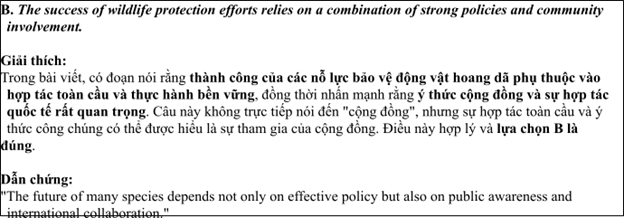[I] In recent years, governments around the world have been increasingly focusing on wildlife conservation. As populations grow and human activities continue to encroach upon natural habitats, the need for stronger wildlife protection measures has become more urgent. [II] Today, many species face the risk of extinction, with some already classified as endangered. By 2030, experts predict that the number of critically endangered species could double if current trends continue. [III] Governments are implementing various strategies to counter this alarming trend, but the effectiveness of these measures depends on global cooperation and sustainable practices. [IV]
One major effort involves strengthening wildlife laws and regulations. For example, many countries have enacted stricter penalties for poaching and illegal trade in animal products. These laws are accompanied by better enforcement and monitoring systems to ensure that violators are caught and punished. Moreover, governments are allocating more resources to create and maintain protected areas, such as national parks and wildlife reserves, where animals can thrive without human interference.
However, wildlife protection is not only about laws and enforcement; it also requires addressing the root causes of habitat destruction. The expansion of urban areas, agricultural land, and infrastructure projects often leads to deforestation and the loss of ecosystems. Governments are now focusing on promoting sustainable land-use practices, such as reforestation and the preservation of key wildlife corridors that connect fragmented habitats. These strategies aim to minimize human impact on wildlife while ensuring that development can proceed in an environmentally responsible way.
Despite these efforts, wildlife protection remains a challenging issue. Deforestation, illegal hunting, and climate change continue to threaten animal populations worldwide. The future of many species depends not only on effective policy but also on public awareness and international collaboration. If governments, environmental organizations, and individuals work together, it is possible to protect endangered species and ensure that wildlife continues to play an integral role in the planet's ecosystems.
(Adapted from discovery channel)
Câu 31. Where in paragraph I does the following sentence best fit?
Governments are increasingly investing in protecting endangered species and their habitats.
A. [I] B. [II] C. [III] D. [IV]
Câu 32. The phrase “counter this alarming trend” in paragraph 3 could be best replaced by ____.
A. prevent this negative development B. reinforce this worrying trend
C. support this ongoing issue D. increase this problem
Câu 33. The word “where” in paragraph 4 refers to ____.
A. laws and regulations B. poaching activities C. protected areas D. urban areas
Câu 34. According to paragraph 4, which of the following is NOT a government effort to protect wildlife?
A. Stronger penalties for illegal wildlife trade
B. Creation of protected areas
C. Promotion of sustainable land-use practices
D. Promotion of unsustainable agricultural practices
Câu 35. Which of the following best summarises paragraph 3?
A. Governments are enhancing wildlife protection through laws, enforcement, and sustainable land-use practices.
B. Global cooperation is needed to address the threats of deforestation and climate change on wildlife.
C. The importance of creating protected areas and wildlife corridors to ensure species survival.
D. Strengthening laws and creating protected areas alone will not save endangered species.
Câu 36. The word “urgent “ in paragraph 1 is OPPOSITE in meaning to:
A. pressing B. important C. unnecessary D. critical
Câu 37. Which of the following is TRUE according to the passage?
A. Wildlife protection efforts focus solely on legal regulations.
B. Governments are addressing both the causes and consequences of wildlife loss.
C. Climate change has no significant impact on wildlife conservation.
D. Deforestation and habitat destruction are not primary threats to wildlife.
Câu 38. Which of the following best paraphrases the underlined sentence: “Despite these efforts, wildlife protection remains a challenging issue” in paragraph 4?
A. Wildlife protection continues to be a difficult challenge, despite the efforts made.
B. Wildlife protection has been completely solved, and there are no more challenges.
C. The efforts in wildlife protection have made the issue less important.
D. Wildlife protection has become easier and less challenging with current efforts.
Câu 39. Which of the following can be inferred from the passage?
A. Wildlife protection is no longer a priority for many governments.
B. The success of wildlife protection efforts relies on a combination of strong policies and community involvement.
C. Governments are failing to protect endangered species due to lack of resources.
D. Governments are not addressing the root causes of habitat destruction effectively.
Câu 40. Which of the following best summarises the passage?
A. Governments are taking action to protect wildlife through stronger laws, protected areas, and sustainable practices, but global cooperation is essential for success.
B. Wildlife conservation is a lost cause unless governments take immediate action.
C. The most effective way to protect endangered species is through stricter penalties for poaching and illegal wildlife trade.
D. Habitat destruction and illegal hunting are the primary causes of species extinction.
Second Semester Midterm Exam GRADE 12 Test 16











